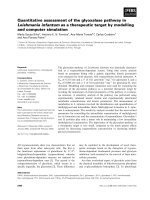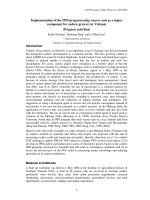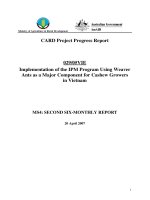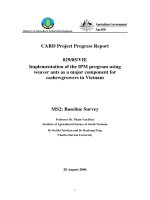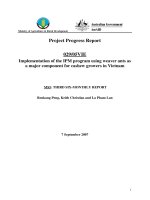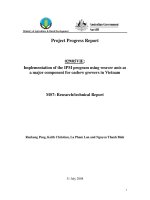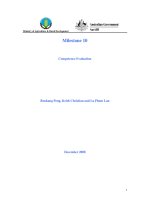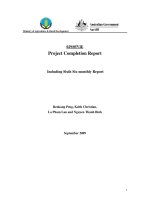Non-English major students’ perceptions and attitudes towards the use of the TOEIC Listening and Reading Test as a graduation requirement
Bạn đang xem bản rút gọn của tài liệu. Xem và tải ngay bản đầy đủ của tài liệu tại đây (1.06 MB, 75 trang )
VIETNAM NATIONAL UNIVERSITY, HANOI
UNIVERSITY OF LANGUAGES AND INTERNATIONAL STUDIES
FACULTY OF POSTGRADUATE STUDIES
*********************
LÊ THỊ NỤ
NON-ENGLISH MAJOR STUDENTS’ PERCEPTIONS AND
ATTITUDES TOWARDS THE USE OF THE TOEIC LISTENING
AND READING TEST AS A GRADUATION REQUIREMENT
(Nhận thức và thái độ của sinh viên không chuyên tiếng Anh về việc sử dụng
bài kiểm tra TOEIC hai kỹ năng nghe và đọc hiểu làm điều kiện tốt nghiệp)
M.A. MINOR THESIS (Type I)
Field: English Teaching Methodology
Code: 8140231.01
Hanoi – 2019
VIETNAM NATIONAL UNIVERSITY, HANOI
UNIVERSITY OF LANGUAGES AND INTERNATIONAL STUDIES
FACULTY OF POSTGRADUATE STUDIES
*********************
LÊ THỊ NỤ
NON-ENGLISH MAJOR STUDENTS’ PERCEPTIONS AND
ATTITUDES TOWARDS THE USE OF THE TOEIC LISTENING
AND READING TEST AS A GRADUATION REQUIREMENT
(Nhận thức và thái độ của sinh viên không chuyên tiếng Anh về việc sử dụng bài
kiểm tra TOEIC hai kỹ năng nghe và đọc hiểu làm điều kiện tốt nghiệp)
M.A. MINOR THESIS (Type I)
Field
: English Teaching Methodology
Code
: 8140231.01
Supervisor : Prof. Dr. Nguyễn Hòa
Hanoi – 2019
DECLARATION
I hereby certify the thesis entitled “non-English major students’
perceptions and attitudes towards the use of the TOEIC Listening and Reading Test
as a graduation requirement” is the result of my own research in fulfillment of the
requirements for the degree of Master of Arts at Faculty of Postgraduate Studies,
University of Languages and International Studies, Vietnam National University,
Hanoi. This thesis has not, wholly or partially, been submitted for an award at any
other universities or higher education institutions.
Hanoi, 20 July 2019
Le Thi Nu
i
ACKNOWLEDGEMENTS
First and foremost, I would like to express my most sincere gratitude to my
supervisor, Prof. Dr. Nguyen Hoa, for his inspiring me to do this research. If it had
not been for his invaluable guidance or insightful comments, my thesis would not
have been accomplished.
My special thanks also go to all the professors and lecturers of Faculty of
Postgraduate Studies at University of Languages and International Studies,
Vietnam National University, Hanoi for their valuable lectures, which have laid the
foundation for this thesis.
I am deeply appreciative to the participants of this study for their immense
contribution by sharing their experiences and opinions. I also thank the director and
employees of the center where the research took place.
Finally, I am indebted to my friends, my colleagues and my family who have
encouraged me in numerous ways to complete this study.
ii
ABSTRACT
This mixed methods study investigated non-English major students’
perceptions of and attitudes towards the use of the TOEIC Listening and Reading
Test as a graduation requirement in some Vietnam‟s HE institutions. Data were
collected from 197 participants through survey questionnaires and eight semistructured interviews at a TOEIC preparation center in Hanoi. The findings revealed
that students generally hold positive attitudes towards the use of the TOEIC scores
to determine their graduation eligibility and believe that preparing to take the test
has a positive impact on their English language proficiency and future employment
prospects. The TOEIC test scores are also perceived favorably by the respondents as
having relatively high levels of reliability and validity; however, the cut-off scores
set by some universities might be too low to motivate their students to study English
harder. The results further indicated that test-takers with better listening and reading
skills as measured by the TOEIC tests have a significantly stronger preference for
the requirement of an adequate level of speaking and writing proficiency before
graduation, provided that tertiary-level English curricula could help students master
the four English language skills. The study not only contributes to our
understanding of students as the key stakeholders who define the context of the test
use but also provides empirical evidence to support the use of the TOEIC test as a
high-stakes standardized test for university exit requirement in Vietnam.
Keywords: Perceptions, attitudes, high-stakes tests, English language
proficiency, TOEIC, test impact, higher education in Vietnam, graduation
requirement
iii
TABLE OF CONTENTS
DECLARATION ........................................................................................................i
ACKNOWLEDGEMENTS ..................................................................................... ii
ABSTRACT ............................................................................................................. iii
TABLE OF CONTENTS .........................................................................................iv
LIST OF ABBREVIATIONS................................................................................ vii
LIST OF TABLES ................................................................................................ viii
CHAPTER I: INTRODUCTION ............................................................................1
1. Background of the study .........................................................................................1
1.1. Social context .....................................................................................................1
1.2. Educational context ............................................................................................2
2. Rationale of the study .............................................................................................3
3. Aim of the study and research questions ................................................................3
4. Methodology and scope of the study ......................................................................4
5. Significance of the study.........................................................................................4
6. Structure of the thesis .............................................................................................5
CHAPTER II: LITERATURE REVIEW...............................................................6
1. High-stakes tests......................................................................................................6
2. Reliability and Validity of standardized tests .........................................................7
2.1. Reliability ...........................................................................................................7
2.2. Validity ...............................................................................................................7
3. Different reactions to high-stakes standardized testing ..........................................8
3.1. Positive reactions ................................................................................................8
3.2 Negative reactions ..............................................................................................9
4. Setting standards of high-stakes testing ................................................................10
5. Preparing students for high-stakes standardized testing .......................................12
6. Perceptions and Attitudes towards high-stakes standardized testing ...................14
6.1. Definitions of Perception and Attitude .............................................................14
iv
6.2. Importance of test-takers‟ perceptions and attitudes towards high-stakes
standardized testing ...................................................................................................15
7. TOEIC as a high-stakes standardized test in Vietnam .........................................16
7.1. What is TOEIC? ...............................................................................................16
7.2. Use of the TOEIC test as a graduation requirement in Vietnam‟s HE
institutions .................................................................................................................17
8. Previous studies on the use of TOEIC as an exit requirement in Vietnam ..........18
9. Summary ...............................................................................................................20
CHAPTER III: METHODOLOGY ......................................................................21
1. Research design ....................................................................................................21
2. Research site .........................................................................................................22
3. Participants............................................................................................................22
3.1. Survey participants ...........................................................................................22
3.2. Interview participants .........................................................................................24
4. Data collection methods........................................................................................24
4.1. Questionnaires ..................................................................................................24
4.2. Interviews .........................................................................................................27
5. Data analysis procedures ......................................................................................29
5.1. Quantitative data analysis .................................................................................29
5.2. Qualitative data analysis ..................................................................................29
CHAPTER IV: RESULTS AND DISCUSSION ..................................................31
1. Research Question 1: What are students‟ perceptions of the English requirement
policy for graduation? ...............................................................................................31
1.1. Results from surveys ........................................................................................31
1.2. Results from interviews ....................................................................................33
2. Research Question 2: What are test-takers‟ perceptions of the appropriateness
and effectiveness of the TOEIC as an exit test?........................................................35
2.1. Results from surveys ........................................................................................35
2.2. Results from interviews ....................................................................................39
v
CHAPTER V: CONCLUSION ..............................................................................44
1. Recapitulation .......................................................................................................44
2. Implications of the study .......................................................................................45
3. Limitations of the study ........................................................................................46
REFERENCES ........................................................................................................47
APPENDICES ........................................................................................................... I
APPENDIX 1: SURVEY QUESTIONNAIRE ....................................................... I
APPENDIX 2: INTERVIEW QUESTIONS....................................................... VII
APPENDIX 3: SAMPLE TEST FOR TOEIC L/R ............................................. IX
vi
LIST OF ABBREVIATIONS
EFL
English as a Foreign Language
ELP
English Language Proficiency
ETS
Educational Testing Service, USA
HE
Higher Education
MOET
Ministry of Education and Training, Vietnam
TOEIC
Test of English for International Communication
vii
LIST OF TABLES
Table 1: Demographic information of participants ...................................................23
Table 2: Structure of survey questionnaire ................................................................25
Table 3: Students‟ opinions about the exit English requirement policy ...................32
Table 4: Students‟ opinions about the exit English requirement policy by their ELP .....32
Table 5: Interviewees‟ perceptions of the exit English requirement policy .............33
Table 6: Survey respondents‟ perceptions of the TOEIC as an exit test ..................36
Table 7: Survey respondents‟ perceptions of the use of the TOEIC as an exit test by
their ELP ...................................................................................................................38
Table 8: Interviewees‟ perceptions of the TOEIC as an exit requirement ................40
viii
CHAPTER I: INTRODUCTION
This chapter introduces the study by outlining the context in which the
research was conducted, the rationale of the study, the purpose and research
questions, the significance of the study, the methodology adopted, and the structure
of the thesis.
1. Background of the study
1.1. Social context
Accompanying the globalization of the English language, a global
commercial testing industry has been established, specially merchandising goods
known as standardized English language proficiency tests. As Templer (2004)
argues, these tests have increasingly controlled access into privileged educational
and occupational paths in the professional and corporate world, and accordingly
affected many local language policies. Heated discussions and concerns have
centered on the impacts of standardized tests on societies and on languages other
than English, and how national and local authorities manage entry to language
education and language rights (Tollefson, 2002).
In Vietnam, among standardized English language proficiency tests, the Test
of English for International Communication (TOEIC) introduced in 2001 has
gradually assumed a greater gate-keeping role. Although it may not be as a wellknown certificate as TOEFL (Test Of English as a Foreign Language) or IELTS
(International English Language Testing System), TOEIC has become a popular
English proficiency test not only in Vietnam but also in some other Asian countries
like Japan, Korea and Taiwan. Being a tool to measure workplace English
proficiency for non-native English speakers, TOEIC certificates are required for job
application in many business corporations in our country such as Viettel, Vietnam
Airlines, LG Electronics, Panasonic, and even in stated-owned financial institutions
including BIDV and Agribank, etc.
1
1.2. Educational context
The importance of English as a lingua franca in the context of the fast
globalization was early acknowledged by the Vietnamese government, and as a
result, English education has been prioritized at all levels of the Vietnamese
education system. At tertiary levels for example, undergraduates generally took 200
hours of English at university over four academic years (Ton & Pham, 2010). Yet,
this instruction was delivered in a manner which did not allow the vast majority of
students to achieve sufficient levels of competence to pass the certifications
required for recruitment. As Ha (2007) indicated, the communicative competence in
English of most Vietnamese employees was still very limited, and many freshly
graduated students failed to find jobs in foreign companies because of the English
language requirements.
Vietnamese decision-making bodies were aware that major changes should
be made to upgrade students‟ English proficiency and get them prepared better for
global competition at the workplace. Accordingly, the Circular No. 05/2012/TTBGDĐT was issued by the Ministry of Education and Training (MOET), effective
as from April 2012, indicating that non-English major graduates need to have
English proficiency equivalent to B1 (CEFR), 450 TOEIC, 450 TOEFL ITP, or 4.5
IELTS. As a result, the majority of HE institutions in Vietnam gradually have set a
requirement for their students to achieve a satisfactory score on one of the
recommended English language proficiency tests before graduation.
The statistics show that approximately 120 HE institutions in Vietnam, over
30 universities in Hanoi alone, are using TOEIC scores normally ranging from 450
to 550 as an exit requirement for their students. For example, the Decision No.
148/QĐ-ĐHBK-ĐTĐH dated 5 September 2017 by the Rector of Hanoi University
of Science and Technology states that non-English majors need present the TOEIC
certificate of minimum 500 points or equivalent certificates before being assigned a
graduation thesis. While this university and some HE institutions such as People's
Security Academy and University of Transport Technology cooperate with the only
2
ETS-authorized organization, IIG Vietnam, to set TOEIC-taking examinations for
their own students; others request their students to take the tests at IIG Vietnam
headquarter by themselves. Obviously, the TOEIC test is now one privileged highstakes standardized test in Vietnam.
2. Rationale of the study
The use of the high-stakes standardized test to determine graduation
eligibility has a direct impact on students who take the test to meet the exit
requirement, and it has important educational and economic implications for
students and society at large. Language learners or students whose education and
language learning are directly influenced by the implementation of the language
graduation requirement policy are perhaps the most important stakeholders in this
testing situation. However, their views on the policy implementation are rarely
considered by university authorities.
Previous research has suggested that learners‟ attitudes towards and
perception of a test and its use can affect their motivation and performance on the
test (Bachman & Palmer, 1996). It has been about seven years since the TOEIC test
was officially used as an exit English test at some HE institutions in Vietnam, but
there is little research examining the appropriateness and effectiveness of the policy,
despite its increasing popularity. This study is an overall investigation into the testtakers‟ own opinions on the English requirement policy for graduation and the use
of the TOEIC certification as an exit requirement at tertiary education levels. Given
that the test takers‟ perceptions can have wide-ranging consequences, opinions
about the use of the TOEIC tests as an exit test may lead to further investigation to
ensure the tests‟ validity.
3. Aim of the study and research questions
The study aims mainly to investigate non-English major students‟
perceptions of and attitudes towards the use of TOEIC Listening and Reading test
scores to determine their graduation eligibility in some HE institutions. However, it
is necessary to examine their perceptions of the English requirement policy for
3
graduation in general first, and then their opinions about the appropriateness and
effectiveness of the TOEIC as an exit test could reveal whether the test use is in line
with the intended purposes of the policy. In order to achieve this aim, the following
objectives were addressed in the study:
-
To identify how non-English major students perceive the English
requirement policy for graduation
-
To investigate the opinions of the students who take the TOEIC Listening
and Reading test for graduation about the appropriateness and effectiveness of this
exit requirement.
With these objectives in mind, the researcher conducted the study to answer
these research questions:
1.
What are non-English major students’ perceptions of the English
requirement policy for graduation?
2.
What are their perceptions of the appropriateness and effectiveness of the
TOEIC as an exit test?
4. Methodology and scope of the study
This study was carried out at a prestigious TOEIC preparation center in
Hanoi, where thousands of students from different universities study to get the
target TOEIC scores for graduation. The quantitative data were collected by means
of survey questionnaires from 197 non-English major students (n = 197), who were
sophomores, juniors, or seniors, of both genders, varied majors and English
proficiency. The follow-up semi-structured interviews of eight participants were
conducted to obtain the qualitative data. Then the quantitative data were analyzed
using SPSS, and the qualitative results were analyzed with the aid of NVivo to
develop themes and codes. The triangulation of quantitative data and qualitative
themes also increased the reliability of the research findings.
5. Significance of the study
As this research is an endeavor to emphasize the importance of listening to
the ideas from students – high-stakes standardized test-takers, there are several
4
significant contributions of this study. First, the findings of this study might
contribute to raise other stakeholders‟ awareness that test takers‟ voices can provide
information about high-stakes standardized English language proficiency tests from
different perspectives. Second, this research gives the participants chances to share
their thoughts and experiences of taking the TOEIC tests as a graduation
requirement. Given that the test takers‟ perceptions can have wide-ranging
consequences, their opinions about the use of the TOEIC tests as an exit test also
encourage a further investigation to ensure the tests‟ validity and reliability. Finally,
investigations into these issues could provide the MOET policymakers and
university authorities with important insights into the appropriateness of the English
graduation requirements or cut-off scores.
6. Structure of the thesis
The thesis contains five chapters including this introduction. Chapter 2
reviews the theories of students‟ perceptions of and attitudes towards high-stakes
standardized tests and some previous studies on the use of the TOEIC test as an exit
requirement in Vietnam. It also identifies the research gap that this study should fill
in. After that, chapter 3- the methodology presents the way this study was
conducted such as the research design, participants, data collection and analysis
procedures. Next, chapter 4 presents the results and discussion of this study. Finally,
chapter 5 reports the conclusion of the study and provides information about the
limitations of this study and recommendations for future studies as well.
5
CHAPTER II: LITERATURE REVIEW
In order to articulate the research questions and identify necessary research
issues, this chapter reviews the literature on main areas: high-stakes tests,
reliability and validity of standardized ELP tests, setting standards and preparing
students for high-stakes standardized testing, students’ perceptions of and attitudes
towards high-stakes standardized tests, and the TOEIC as a high-stakes
standardized test in Vietnam. Also, some previous studies on the use of the TOEIC
test as an exit requirement in Vietnam are reviewed to identify the research gap that
this study should fill in.
1. High-stakes tests
High-stakes tests usually refer to large-scale standardized tests or public
examinations, whose results are used for making important educational and
professional decisions about individuals, such as admissions, graduation,
employment, or promotion (Madaus, 1988). High-stakes testing policies “represent
a motivational policy” (Ryan & Brown, 2005, p. 358) which applies performance
contingent rewards and punishments to standardized test scores. Performance
contingent rewards refer to those given for satisfying or surpassing a certain
requirement or standard, whereas performance-contingent punishments are those
given for failing it (Deci & Moller, 2005).
Under high-stakes testing policies, schools, teachers, and students are the key
stakeholders affected. For schools, the received amount of subsidies or grants could
be determined by students‟ test results or performance ratings. For teachers, their
teaching might be evaluated based on their students‟ test scores. For students, if
they perform up to certain standards, they are rewarded through praise or through
concrete rewards, such as money; in contrast, if they perform badly or fail the test,
they could be punished by being held back in school or being unable to graduate
(Kohn, 2000). From this perspective, high-stakes testing can create a context where
the stakeholders (i.e., schools, teachers, and students) direct their attention to test
score results and external contingencies.
6
2. Reliability and Validity of standardized tests
2.1. Reliability
In discussing the same candidate writing the same test at a different time,
Hughes (1989) notes, “the more similar the scores would have been, the more
reliable the test is said to be” (p. 29). While this view of reliability issues being the
result of random measurement error is quite common (Lewis, 1999), Bachman
(1990) uses a broader definition encompassing not only “how much of an
individual‟s test performance is due to measurement error”, but also how much is
due “to factors other than the language ability we want to measure” (p. 160).
Bachman (1990) discusses three factors that may affect test reliability. The
first are Test Method Facets, which are broken down into the five categories of
testing environment, test rubric (organization), input (format of and nature of),
expected response (format of, nature of, and restrictions on), and the relationship
between input and expected response (reciprocal, non-reciprocal, adaptive). The
second are Personal Attributes and include aspects such as age, gender, cognitive
style and, background. The third are Random Factors and can include aspects such
as tiredness and a candidate's emotional condition, as well as random differences in
the testing environment.
2.2. Validity
In defining validity, Hughes (1989) states, “a test is said to be valid if it
measures accurately what it is intended to measure” (p. 22), while Bachman (1990)
on validity notes, “In examining validity, we look beyond the reliability of the test
scores themselves, and consider the relationships between test performance and
other types of performance in other contexts.‟‟ (p. 236). Bachman further quotes the
standards of educational and psychological testing as in part saying, “validity
always refers to the degree to which the evidence supports the inferences that are
made from the scores” (1990:237).
Bachman goes on to point out that reliability and validity are not independent
entities, but are complementary in that reliability is a necessary condition for
7
validity (1990:160). Thus, a certain grammar test may be highly reliable, yet not
considered a valid test of spoken English, while a poorly assessed spoken test may
have low reliability but may otherwise be considered valid for its purpose.
3. Different reactions to high-stakes standardized testing
3.1. Positive reactions
The use of high-stakes standardized testing and its impact on educational
contexts remain controversial. Policymakers intend to use high-stakes standardized
tests to make desired educational changes. They argue that “the promise of rewards
or the threat of sanctions is needed to ensure change” (National Research Council,
1999, p. 35), which assumes that the behaviors that the stakeholders adopt
associated with high scores will be reinforced, whereas those with poor test
performance will be diminished. From this perspective, high-stakes standardized
tests have been treated as powerful and “effective tools for controlling educational
systems and prescribing the behavior of those who are affected by their results”
(Shohamy et al., 1996, p. 299).
Many agree on the usefulness of the use of external contingencies to control
behaviors. Shanker (1993, as cited in Ryan & Brown, 2005) argues that when the
achievement outcomes, such as test scores, are significantly attached to the
consequences, students will have “the incentive to work hard and achieve because
they know something important…is at stake” (p. 9). Finn (1991) also holds that
high-stakes standardized testing can effectively change student‟s learning behavior
when contingent rewards and sanctions exist behind the test results. Thomas (2005)
argues that some students under high-stakes testing policies will be more motivated
to exert more effort to improve their test scores in the future. Stecher (2002) also
concludes that students with high-stakes testing are motivated to put in more effort,
know better about their own abilities and what to study, and align their own effort
with rewards.
Some research studies also demonstrate the potential positive effects of highstakes standardized testing on students. For example, in their qualitative study
8
focusing on the impact of a high-stakes test on 102 low-achieving students in
Chicago public schools, Roderick and Engel (2001) found that lower-performing
students could hold positive attitudes towards the high-stakes testing policies if the
goal is perceived achievable. They further suggest that these students would be
motivated to study harder if they are provided with “incentives… through goals that
provide an opportunity for feedback, a tangible reward, and a way to construct
meaning regarding learning” (p. 219).
3.2 Negative reactions
The power and controlling nature of high-stakes standardized testing have
been subject to criticism for its potential undesirable consequences (Ryan & Brown,
2005). The study conducted by Noble and Smith (1994) shows that when high
stakes is placed behind test performance, teachers tend to focus on the activities that
could boost test scores, such as practicing test-taking skills or reviewing past
examination papers, and their students are thus directed to learn toward the test
rather than to enhance long-term knowledge growth.
Amrein and Berliner (2002) took a comprehensive look at the consequences
of high-stakes standardized tests by conducting a state-by-state analysis in the U.S.
A total of states were included and four separate standardized state tests (i.e., the
American College Testing Program (ACT), Scholastic Aptitude Test (SAT),
National Assessment of Educational Progress (NAEP), and Advanced Placement
(AP) were examined. The analyses revealed that the state‟s high-stakes testing
policy failed to enhance transfer. Amrein and Berliner (2002) found that after the
policy was implemented, the students from two-thirds of states performed worse on
the ACT; in other words, these students did not perform better on the outside tests,
although increased scores were shown on the state‟s high-stakes test. Some other
studies (Stecher, 2002; Ryan & Brown, 2005) also raise some other concerns other
negative impacts of high-stakes testing on students, such as decreasing intrinsic
motivation, stimulating test anxiety and frustration, being more competitive, and
using more inappropriate test-taking strategies.
9
4. Setting standards of high-stakes testing
Thomas (2005) indicated that five of the more popular criteria used in the
U.S. to set standards for high-stakes tests are: (a) the ideal student, (b) the attainable
level, (c) other students, (d) each student‟s own record, and (e) some combination of
(a)–(d) (p. 59).
The criterion of “the ideal student” is the standard of a person who is ideally
fitted to display all worker-virtues at a high level of efficiency after entering the
workforce and able to attain an optimal degree of self-fulfillment. Business
executives are most impressed by these features of high level of attainment when
selecting their employees. However, to apply such a standard, education leaders are
obligated to explain and specify the numbers of test items and the level of difficulty
in each test, which can increase the level of difficulty in practice. As Thomas
singled out, the ideal level of this standard will be too high if only a small portion of
learners earn acceptable marks, and will be too low if an excessively large
proportion of students receive extremely high ratings.
The attainable level is the criterion that education leaders (such as policy
makers, administrators, test-makers, or teachers) believe that most students can
answer correctly if their students have studied diligently. The assumption of this
standard implied that all participants can master all of the learning objectives. For
the purpose that all students or nearly all students are to pass, the standard tends to
be set at a level that the least adept can reach. This low expectation may “result in
the average and above-average students not being challenged to exert their best
effort, because they lack the incentive to learn far beyond the limits of such an
expectation” (p. 60). Failing a test can “motivate some learners to greater effort to
score higher in the future” (Thomas, 2005, p. 61). However, if the attainable level is
mandated to such a high standard that few learners reach it, the large portion of the
students who fall below the pass line may hold negative views about their abilities
and “view themselves as failures.” Some students, who already have been working
diligently and still fail, may become discouraged, give up and drop out.
10
Additionally, having a high proportion of students fail to pass the tests after
applying this criterion manifests that “the instruction has been very poor, or that the
methods of evaluating student progress have been faulty, or that the achievement
standards have been unreasonably strict” (p. 60).
The criterion of “other students”, according to Thomas‟s categorical
definition, compared students‟ performances to those of their classmates, grademates, or age-mates. The school administration can avoid being accused of setting
an unreasonably high or low attainment level. However, the decisions for the cut-off
score (which is subjectively decided by opinion) to distinguish students‟ passing or
failing will be challenging to policy makers, administrators, test-makers and
teachers, which is subjectively decided (p. 61).
The criterion of “each student‟s own record” drew on the judgment of
passing or failing a test by focusing on the progress that each student has made for a
given period of time. This individual-progress approach has been highly eulogized
for its promotion of the goal of developing a person‟s potential of being what he or
she is capable of. However, Thomas explained that the drawbacks of this type of
criterion-setting are (a) developing a false sense of a person‟s actual ability if only
comparing against his or her past record; (b) failing to provide information about
how a learner performs compared with other age-mates or global counterparts of the
same age and (c) suffering rude shock in the real world after a learner realizes that
the high grade received in school for his or her moderate improvement was
unrealistic and devastating.
The Hybrid Approach to combining the features of the ideally-educatedperson, attainable-level, and student-comparisons criteria is the fifth popular
achievement standard proposed by Thomas. The combination of above-mentioned
perspectives is a viable alternative in terms of setting achievement standards. The
whole learning process is regarded as a system arranged in hierarchical stages
combining all these elements. The student-comparisons aspect can be viewed as the
starting stage for setting their criteria of learning and testing at their own learning
11
pace, specifically to the learning disadvantaged student group that should pass the
required tests during any given year in order to avoid the failure label. The
attainable-level element is found in the stage of progress as proposed each year by
the school authorities so that eventually every learner can attain the standard set by
their school in a certain given period of time. The ideally-educated-person element
is obviously represented by the ideal alternate aim to have virtually all students
proficient in knowledge and practical skills in the related field after they graduate
from schools.
In summary, Thomas (2005) denoted that people‟s beliefs about “sufficient
competency” and “fair treatment” can lead to their disagreement with the test-score
levels or cut-off points by which to determine the designations success or failure of
a test (p. 76). Disagreement in proper standards of tests is bound to continue.
Expecting complete accord regarding standards-setting is challenging and
unrealistic.
5. Preparing students for high-stakes standardized testing
Crocker (2005) defined appropriate test preparation as “instruction that is
geared not only toward study of content from the domain of knowledge sampled by
the test, but also toward practicing the skills that will allow students to demonstrate
their knowledge on various types of assessment exercises” (p. 161). He explained
that teaching for assessment occurs when students are taught “the broader content
domain represented by the curricular standards, not simply to that subset of content
sampled by the items on a single test form”. He used the term “teaching “for” the
test” to distinguish the negative connotation of “teaching to the test”. When dealing
with students‟ urgent needs in high-stakes English exit examinations, test
preparation is the primary concern. Four essential elements of teaching for the test
include: (a) a challenging core curriculum, (b) comprehensive instruction in that
curriculum, (c) developing students‟ test-taking skills, and (d) adherence to ethical
guidelines regarding preparation of students for assessment (Crocker, 2005).
12
Approaches to test preparation offered by Smith and Delisi (2001) were
useful to classroom instructors in differentiating curriculum alignment from
measurement-driven instruction. The four stages of test preparation for instructors
were as follows: “(a) teach without paying attention to the standardized test and
hope that the students‟ abilities will show through on the assessment; (b) spend
most of the time in instruction as instructors normally do, but spend some time
going over item formats to be found on the assessment so that students will be
familiar with these formats; (c) analyze the content of the assessment, make certain
that instructors cover the content in the regular instructional program, then work on
item format and test taking skills as well; (d) analyze the content of the assessment
and restructure the instructional program around that content exclusively” (Crocker,
2005, pp. 90-91). The first approach illustrates teaching without test preparation and
without curricular alignment. The second approach illustrates instruction without
curricular alignment, but with some attention to test-taking skills. The third
approach describes a reasonable balance of instruction with curricular alignment
and instruction in test taking skills, especially there is concerted effort to teach
subject matter knowledge and test taking skills that will have broad utility to the
students beyond this immediate examination situation. Two important premises of
undertaking the third approach are that (a) the assessment represents a good sample
of the core curriculum, and (b) the core curriculum is worthy and important. The
fourth approach crosses alignment the line toward measurement-driven instruction.
Crocker (2005) used various sources to develop his classroom strategies of
proper test preparation (Campanile, 1981). Some of these strategies included: (a)
demonstration of a positive attitude toward test preparation with students and
parents, (b) building concentration endurance in test-like conditions without
becoming fatigued or distracted, (c) practicing various test item formats with
instructions and answer sheets as those on the tests, (d) timing practice tests, (e)
modeling good problem-solving strategies (how to approach the test items, to
13
determine the meaning of the question, to provide various ways of posing the same
question, and to arrive at the correct answer), (e) practicing working through tests
with various difficulty levels, (f) diagnosing any response patterns that needed to be
corrected before testing through homework grading or class work, (g) building
students‟ test-taking vocabulary, (h) explaining how score rubrics are used to award
points for performance assessment items, providing examples of responses
generating full, partial, or no credit, and helping students evaluate their responses.
Crocker (2005) also suggested four criteria for determining if classroom
instruction practice is ethical. These four criteria are as follows: (a) Academic
ethics: test preparation should be guided by the ethical cannons of the education
profession, dealing with cheating, misrepresentation, and respect for intellectual
property or work of others (Popham, 1991); (b) Validity: Test preparation should
improve validity of test scores by allowing only students who have knowledge or
partial knowledge of content being tested in an exercise to display that
knowledge; (c) Transferability: Test preparation should provide student with
skills that have applicability to a broad range of testing situations (Popham,
1992); (d) Educational value: test preparation that leads to improvement in
student scores should simultaneously increase student mastery of the content
domain tested (Popham, 1991).
6. Perceptions and Attitudes towards high-stakes standardized testing
6.1. Definitions of Perception and Attitude
According to Campbell (1967), perception is a process where one will form
an impression about someone or something. Based on the definition, perception is
constructed as a result of individual observation towards certain things or events
occurring around them which will produce certain perception. The perception then
affected their attitude towards certain matters or objects of attitudes.
Lindsay and Norman (1977) stated that perception is the process by which
organisms interpret and organize sensation to produce a meaningful experience of
the world. The researchers describe the definition into two categories, which are
14
sensation and perception. Sensation refers to the immediate, relatively
unprocessed result of stimulation of sensory receptors in the eyes, ears, nose,
tongue, or skin. Sensations refer to the human sensory systems which function as
the receptor of information regards certain matters or object observed by an
individual. It is the stimulation process where the input is transferred directly to
the human brain. On the other hand, perception refers to the one‟s ultimate
experience of the world and typically involves further processing of sensory
input. Perception involved more process of thinking as a result of the
information received from the sensory systems as regards certain things or
events. It is the output process where the judgments or beliefs were produced by
an individual and it influenced the way they think and feel.
Gardner (1985, p. 9) stated that attitude is an evaluative reaction to some
referent or attitude objects, inferred on the basis of the individual‟s beliefs or
opinions about the referent. Ajzen and Fishbein (2005, p. 3) defined that attitude is a
disposition to respond favorably or unfavorably to an object, person, institution, or
event. The definitions of attitudes has been varied as a result of continues studies
done by researchers. Even though the researchers have their own definition of
attitudes, they still share the facts that attitudes guide and direct an individual‟s
behavior. Attitude is more to how human perform their thinking or their reaction
toward certain things or matters. Meanwhile, perception did not involve action as it
is more to the way of human thinking. Nevertheless, perception and attitudes are
related as perception is the root of thinking which invoke certain judgments or
beliefs that influence human attitude.
6.2. Importance of test-takers’ perceptions and attitudes towards high-stakes
standardized testing
Shohamy (2001a) argued that listening to the test-takers‟ voices about tests
will lead to a better understanding about tests, especially for high-stakes tests which
have powerful effects not only in students‟ educational lives, but also in their social
lives. That is, while high-stakes test takers are often considered passive participants
15
